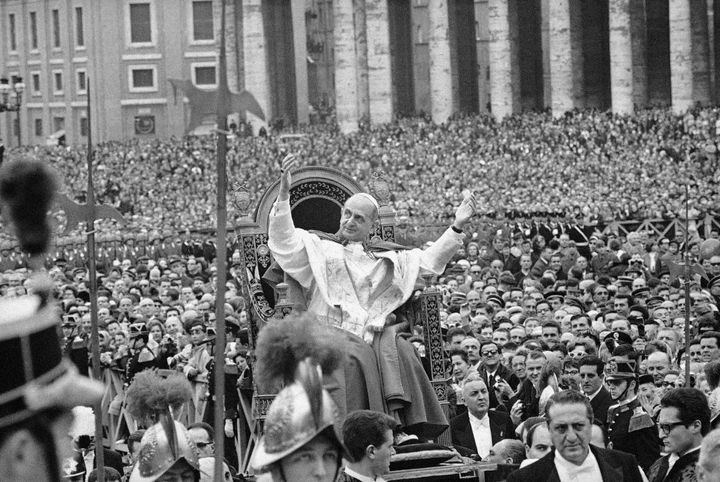By Lisa McClain, Boise State University/The Conversation
This month marks the 50th anniversary of the landmark “Humanae Vitae,” Pope Paul VI’s strict prohibition against artificial contraception, issued in the aftermath of the development of the birth control pill. At the time, the decision shocked many Catholic priests and laypeople. Conservative Catholics, however, praised the pope for what they saw as a confirmation of traditional teachings.

Pope Paul VI banned contraception for Catholics in the 1968 encyclical, “Humanae Vitae.”
As a scholar specializing in both the history of the Catholic Church and gender studies, I can attest that for almost 2,000 years, the Catholic Church’s stance on contraception has been one of constant change and development.
And although Catholic moral theology has consistently condemned contraception, it has not always been the church battleground that it is today.
Early church practice
The first Christians knew about contraception and likely practiced it. Egyptian, Hebrew, Greek and Roman texts, for example, discuss well-known contraceptive practices, ranging from the withdrawal method to the use of crocodile dung, dates and honey to block or kill semen.
Indeed, while Judeo-Christian scripture encourages humans to “be fruitful and multiply,” nothing in Scripture explicitly prohibits contraception.
When the first Christian theologians condemned contraception, they did so not on the basis of religion but in a give-and-take with cultural practices and social pressures. Early opposition to contraception was often a reaction to the threat of heretic groups, such as the Gnostics and Manichees. And before the 20th century, theologians assumed that those who practiced contraception were “fornicators” and “prostitutes.”
The purpose of marriage, they believed, was producing offspring. While sex within marriage was not itself considered a sin, pleasure in sex was. The fourth-century Christian theologian Augustine characterized the sexual act between spouses as immoral self-indulgence if the couple tried to prevent conception.
Not a church priority
The church, however, had little to say about contraception for many centuries. For example, after the decline of the Roman Empire, the church did little to explicitly prohibit contraception, teach against it, or stop it, though people undoubtedly practiced it.
Most penitence manuals from the Middle Ages, which directed priests what types of sins to ask parishioners about, did not even mention contraception.
It was only in 1588 that Pope Sixtus V took the strongest conservative stance against contraception in Catholic history. With his papal bull “Effraenatam,” he ordered all church and civil penalties for homicide to be brought against those who practiced contraception.
However, both church and civil authorities refused to enforce his orders, and laypeople virtually ignored them. In fact, three years after Sixtus’s death, the next pope repealed most of the sanctions and told Christians to treat “Effraenatam” “as if it had never been issued.”
By the mid-17th century, some church leaders even admitted couples might have legitimate reasons to limit family size to better provide for the children they already had.
Birth control becomes more visible
By the 19th century, scientific knowledge about the human reproductive system advanced, and contraceptive technologies improved. New discussions were needed.
Victorian-era sensibilities, however, deterred most Catholic clergy from preaching on issues of sex and contraception.
When an 1886 penitential manual instructed confessors to ask parishioners explicitly whether they practiced contraception and to refuse absolution for sins unless they stopped, “the order was virtually ignored.”
By the 20th century, Christians in some of the most heavily Catholic countries in the world, such as France and Brazil, were among the most prodigious users of artificial contraception, leading to dramatic decline in family size.
As a consequence of this increasing availability and use of contraceptives by Catholics, church teaching on birth control – which had always been there – began to become a visible priority. The papacy decided to bring the dialogue about contraception out of scholarly theological discussionsbetween clergy into ordinary exchanges between Catholic couples and their priests.
Regarding his frank 1930 pronouncement on birth control, “Casti Connubii,” Pope Pius XI declared that contraception was inherently evil and any spouse practicing any act of contraception “violates the law of God and nature” and was “stained by a great and mortal flaw.”
Condoms, diaphragms, the rhythm method and even the withdrawal method were forbidden. Only abstinence was permissible to prevent conception. Priests were to teach this so clearly and so often that no Catholic could claim ignorance of the Church’s prohibition of contraception. Many theologians presumed this to be an “infallible statement” and taught it thus to Catholic laypersons for decades. Other theologians saw it as binding but “subject to future reconsideration.”
In 1951, the church modified its stance again. Without overturning “Casti Connubii’s” prohibition of artificial birth control, Pius XI’s successor, Pius XII, deviated from its intent. He approved the rhythm method for couples who had “morally valid reasons for avoiding procreation,” defining such situations quite broadly.
The pill and the church
By the early 1950s, however, options for artificial contraception were growing, including the pill. Devout Catholics wanted explicit permission to use them.
Church leaders confronted the issue head-on, expressing a variety of viewpoints.
In light of these new contraceptive technologies and developing scientific knowledge about when and how conception occurs, some leaders believed the church could not know God’s will on this issue and should stop pretending that it did, as Dutch Bishop William Bekkers said outright on national television in 1963.
Even Paul VI admitted his confusion. In an interview with an Italian journalist in 1965, he stated,
“The world asks what we think and we find ourselves trying to give an answer. But what answer? We can’t keep silent. And yet to speak is a real problem. But what? The Church has never in her history confronted such a problem.”
There were others, however, such as Cardinal Alfredo Ottaviani, leader of the Congregation for the Doctrine of the Faith – the body that promotes and defends Catholic doctrine – who disagreed. Among those adamantly convinced of the truth of the prohibitions was the Jesuit John Ford, perhaps the most influential U.S. Catholic moralist of the last century. Although no Scripture mentioned contraception, Ford believed the church’s teachings were grounded in divine revelation and therefore not to be questioned.
The question was left for consideration by the Pontifical Commission on Birth Control, held between 1963 to 1966. This commission by an overwhelming majority – a reported 80 percent – recommended the church expand its teaching to accept artificial contraception.
That was not at all unusual. The Catholic Church had changed its stance on many controversial issues over the centuries, such as slavery, usury and Galileo’s theory that the Earth revolves around the sun. Minority opinion, however, feared that to suggest the church had been wrong these last decades would be to admit the church had been lacking in direction by the Holy Spirit.
‘Humanae Vitae’ ignored

A protest in Charleston, S.C., in 2012, against a federal mandate requiring employers to provide health insurance that includes birth control for workers.
Paul VI eventually sided with this minority view and issued “Humanae Vitae,” prohibiting all forms of artificial birth control. His decision, many argue, was not about contraception per se but the preservation of church authority. An outcry ensued from both priests and laypeople. One lay member of the commission commented,
“It was as if they had found some old unpublished encyclical from the 1920s in a drawer somewhere in the Vatican, dusted it off, and handed it out.”
Much has changed in the Catholic Church since 1968. Today, priests make it a pastoral priority to encourage sexual pleasure between spouses. While prohibitions on birth control continue, many pastors discuss the reasons a couple might want to use artificial contraception, from protecting one partner against a sexually transmitted disease to limiting family size for the good of the family or the planet.
Despite the changes in the church’s attitudes about sex, the prohibitions of “Humanae Vitae” remain. Millions of Catholics around the world, however, have simply chosen to ignore them.
This article was originally published on The Conversation, a source for analysis from experts writing engagingly for the public. Read more ethics and religion articles here. Lisa McClain is Professor of History and Gender Studies, at Boise State University.
